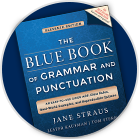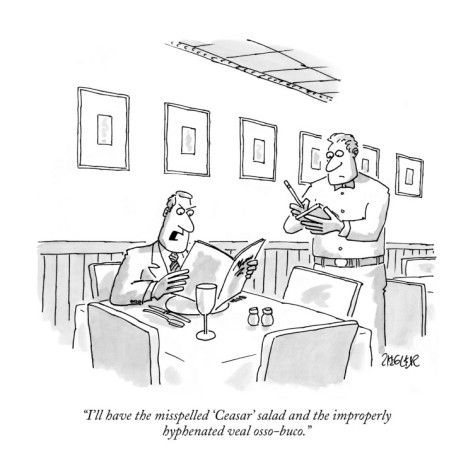|
Punctuating Compounds That Precede
|
|
It's enough to drive even the most exacting writers, proofers, and editors
a little batty sometimes: More than one descriptive word precedes a noun,
forming what we call a compound modifier. Do we need to hyphenate
the words, or are they well enough left alone? What if we have two words
modifying another word and all three describe the same noun, creating a
package that begs for punctuation?
Sometimes the solution is simple, as we've covered in our hyphen rules. Rule 1 advises hyphenating two or more words acting as a single idea when
they come before a noun (late-arriving train, ne'er-do-well teenager, one-of-a-kind invention).
Exceptions to this rule are compound modifiers that include adverbs such as much and very as well as any -ly adverb (much maligned administrator, very good cake, easily remembered song).
We also wouldn't hyphenate a compound that's an obvious unit such as most
proper nouns (Social Security check) and foreign expressions (quid pro quo exchange).
When a two-word descriptor takes the form of a compound noun (e.g., real estate, high school, sales tax), hyphenation becomes a matter
of preference. Some writers and editors identify the compound nouns as
clearly understood units while others still hyphenate them to maintain
stylistic consistency and remove any chance of confusion.
Examples:
real estate advisor
vs.
real-estate advisor
high school dance
vs.
high-school dance
sales tax increase
vs. sales-tax increase
In Rule 5 of Hyphens,
we also emphasize including a hyphen with a compound modifier anytime
omitting one could lead to ambiguity.
Potentially misaimed:
Springfield has little town charm.
(If we omit the hyphen, we're suggesting Springfield lacks appeal. Is that
what we want to say?)
Clearer with hyphen:
Springfield has little-town charm.
(The punctuation establishes that Springfield has the charm of a small,
cozy town.)
Potentially misaimed:
That is a fast running machine.
(Is it a machine that runs fast, or a running machine [i.e., a treadmill]
that operates faster than others?)
Clearer with hyphen:
That is a fast-running machine.
(a machine that runs fast)
The guidelines thus far help define and apply hyphenation of preceding descriptors. The next question concerns what to do when we run into phrases such as stippling technique influenced painter and apple orchard scented candle.
If we employ basic hyphenation, we wind up with phrases such as stippling-technique-influenced painter and apple-orchard-scented candle. While such punctuation can be acceptable, it can also be
unsightly and distracting. Some editors feel it muddles phrasal components of careful
writing.
To solve this, some style guides turn to the en dash, which is longer than
the hyphen and shorter than the em dash. We have explored the mark in The Elusive En Dash. The article points out that many daily publications and their supporting
style guides, such as The Associated Press Stylebook, do not use
the en dash for compound descriptors. Conversely, most books and other
formal publications and their style guides, including The Chicago Manual of Style, do apply it (CMOS recommends
using it sparingly).
In careful writing, the hyphen connects immediately related words (late-arriving train, little-town charm). The en dash more clearly identifies descriptive units within modifiers of three or more words when they include a compound noun. In stippling technique influenced painter, stippling technique is a compound noun modifying influenced. It therefore remains open (no punctuation); it is then connected as a multipart modifier to influenced with the en dash. In total, the three descriptive words complete the noun phrase stippling technique–influenced painter.
If we write other mutations such as
stippling technique-influenced painter and stippling-technique–influenced painter,
we compromise accurately marked word relationships and correct
treatment of parts of speech. We also create traffic jams of punctuation.
The same principles apply to apple orchard–scented candle. Apple orchard is the compound noun left open to identify it as
such. The en dash then connects the compound unit to scented to
complete the three-word modifier of candle.
In step with all of our grammatical principles, our aim is always precision
and clarity. While you may not see them working together very often, further understanding the functions of the hyphen and the en
dash will sharpen your mission to write with precision.
|
View and comment on this
article on our website
|
|
Pop Quiz
In the following sentences, identify whether the italicized phrase would
require a hyphen, an en dash, or no punctuation because it is a compound
noun.
1. The expensive looking car must belong to one of those pro
athletes over there.
a) hyphen: expensive-looking car
b) en dash: expensive–looking car
c) no punctuation: expensive looking car
2. The corn starch amended food is cheaper to produce but now
lesser in protein.
a) hyphen: corn-starch amended food
b) en dash: corn starch–amended food
c) no punctuation: corn starch amended food
3. I’ve been waiting at the train station for more than two
hours.
a) hyphen: train-station
b) en dash: train–station
c) no punctuation: train station
|
Free BONUS Quiz for You!
[[firstname]], because you are a subscriber to the newsletter, you get access to one of the Subscribers-Only Quizzes. Click here to take a Hyphens with ly Words Quiz and get your scores and explanations instantly!
We will be adding many more quizzes this year to our already substantial list of quizzes. If you have suggestions for topics we have not yet covered, please send us a message at help@grammarbook.com.
|
 |
The Blue Book of Grammar and Punctuation
by Jane Straus, Lester Kaufman, and Tom Stern |
The Authority on English Grammar! Eleventh Edition Now Available
An indispensable tool for busy professionals, teachers, students, homeschool families, editors, writers, and proofreaders.
Available in print AND as an e-Book! Over 2,000 copies are purchased every month!
The publisher of The Blue Book, Jossey-Bass, A Wiley brand, is offering a 35 percent discount for those of you who order the book through Wiley.com. Shipping and tax are not included. Simply go to bit.ly/1996hkA and use discount code E9X4A.
Offer expires December 31, 2018.
|
Hundreds of Additional Quizzes
at Your Fingertips
New quizzes on Clauses and Phrases recently added!
Subscribe now to receive hundreds of additional English usage quizzes not found anywhere else!
Teachers and Employers
Save hours of valuable time! You may assign quizzes to your students and employees and have their scores tallied, organized, and reported to you! Let GrammarBook.com take the hassle out of teaching English!
"Fun to test my skills."
"The explanations really help ... thanks!"
"I can select the quizzes to assign to my students, and then the results are reported to me automatically!"
|

|
Don't need all the quizzes?
You can now purchase the same quizzes individually for ONLY 99¢ each.
Purchase yours here.
|
If you think you have found an error in a quiz, please email us at help@grammarbook.com
|
Wordplay

Pop Quiz Answers
1. a) The expensive-looking car must belong to one of those pro
athletes over there.
Explanation: expensive-looking is a compound modifier of car.
2. b) The corn starch–amended food is cheaper to produce but
now a lesser source of protein.
Explanation: the words corn starch amended modify food, and corn starch is a compound noun describing amended.
3. c) I’ve been waiting at the train station for more than
two hours.
Explanation: train station is a compound noun not modifying
another word.
|
 |
English In A Snap:
68 One-Minute English Usage Videos FREE |
Learn all about who and whom, affect and effect, subjects and verbs, adjectives and adverbs, commas, semicolons, quotation marks, and much more by just sitting back and enjoying these easy-to-follow lessons. Tell your colleagues (and boss), children, teachers, and friends. Click here to watch.
|
|





